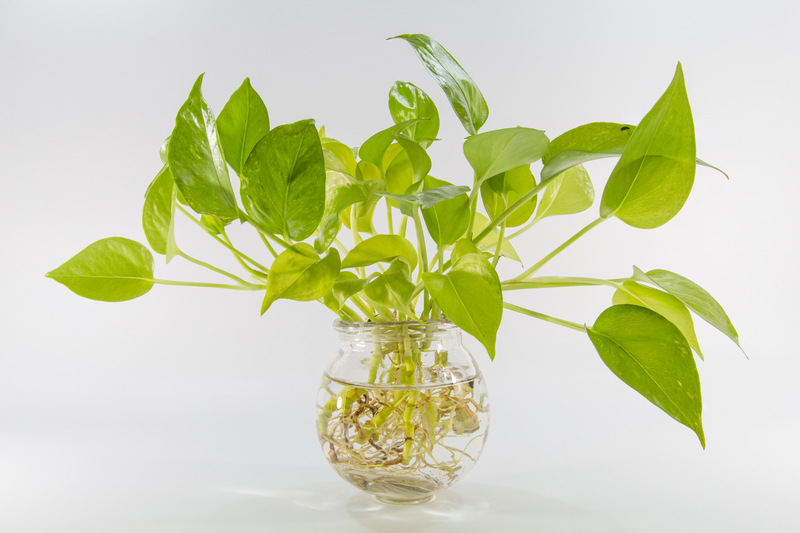Vertical Gardening: Crafting Living Artwork for Your Space
Posted on 04/06/2025
Vertical Gardening: Crafting Living Artwork for Your Space
Vertical gardening is rapidly transforming the way we experience indoor and outdoor spaces. Once viewed simply as a clever solution to spatial challenges, it now serves as a canvas for artistic expression, sustainability, and wellness. Whether you're an urban dweller seeking to bring a touch of nature to your apartment or a homeowner eager to make a bold design statement, vertical gardens offer a wealth of opportunities to elevate your environment. This guide will explore everything you need to know about creating living artwork through vertical gardening, ensuring your efforts are as successful as they are stunning.
What is Vertical Gardening?
Vertical gardening refers to the practice of growing plants upward, using vertical space instead of traditional horizontal gardening beds. This approach can utilize a variety of structures, such as walls, trellises, shelves, or even hanging systems to support plant life. The result is a lush, layered tapestry of greenery that not only saves space but also doubles as an enchanting natural masterpiece.
- Space Saving: Ideal for small balconies and interiors
- Flexible Design: Can be adapted to almost any surface
- Artistic Element: Functions as a living painting or sculpture
- Environmental Benefits: Improves air quality and insulation

Benefits of Vertical Gardening: More Than Just Space Saving
Vertical gardens offer a multitude of advantages aside from maximizing your available area:
1. Enhanced Aesthetic Appeal
Vertical plant walls act as living artwork, transforming plain surfaces into vibrant displays of texture and color. They allow you to integrate your personal tastes by mixing and matching plant species, flower hues, and arrangements.
2. Improved Air Quality
Plants absorb toxins and release oxygen, making vertical gardens a natural air purifier in both homes and offices. Larger installations can significantly reduce airborne pollutants for a fresher, more invigorating atmosphere.
3. Temperature Regulation and Insulation
Vertical gardens act as natural insulation, helping regulate temperature inside buildings. The layer of plants and soil can reduce heat absorption in summer and maintain warmth during winter.
4. Noise Reduction
Dense greenery absorbs sound, so a well-crafted vertical garden can provide welcome acoustic insulation in noisy city environments or open-plan offices.
5. Boosts Well-Being
Numerous studies have found that being surrounded by plants has a positive effect on mood, productivity, and overall well-being. Vertical gardens increase your daily touchpoints with nature, especially for those with hectic lifestyles or minimal access to green spaces.
Vertical Gardening vs. Traditional Gardening: Key Differences
- Orientation: Vertical gardening uses upward surfaces, traditional gardening relies on ground beds.
- Space Utilization: Vertical gardens maximize limited spaces, ideal for urban settings.
- Accessibility: Plants are easier to reach and maintain at eye-level and above.
- Creative Expression: Design possibilities for vertical plant artwork far outstrip classic bed layouts.
- Plant Choices: Certain species are better suited for vertical systems, making planning crucial.
Types of Vertical Gardens: Exploring Creative Possibilities
1. Living Walls (Green Walls)
These are fully-covered panels or structures densely packed with plants, often integrated into the architecture itself. Living walls can be modular--using framed planters or felt pockets--or "blanket" systems, which rely on mats or mesh with growing medium.
2. Trellis Gardens
Ideal for climbing plants like ivy, jasmine, or tomatoes, trellises provide a vertical framework for vines to grow upward, creating green curtains, screens, or boundaries.
3. Hanging Gardens
These utilize suspended containers, pots, or baskets arranged in clusters or rows. They're perfect for balconies, patios, or interiors where wall space is limited.
4. Pallet and Pocket Gardens
Repushed wooden pallets or fabric pockets attached to walls serve as cost-effective and customizable planters--a popular DIY solution for herbs, succulents, or small flowering plants.
5. Freestanding Towers and Columns
Modular tower gardens are ideal for hydroponic setups, allowing you to grow a vertical vegetable garden anywhere sunlight is available.
Designing Your Vertical Garden: Tips for Crafting Living Art
Step 1: Assess Your Space & Lighting
Analyze whether your vertical garden design will be indoors or outdoors, and note how much sunlight or shade the area receives. Use south or west-facing walls for sun-loving species; low-light interior corners work well with hardier, shade-tolerant plants like ferns or pothos.
Step 2: Choose Your Structure
- Pre-made Panels: Ideal for beginners and indoor use
- DIY Pockets or Pallets: Budget-friendly and customizable
- Wire Mesh/Trellis: Best for climbing plants and outdoor setups
- Hydroponic Towers: Modern, high-yield solutions for veggies and herbs
Step 3: Select the Right Plants
*Pick plants suited to your space's light, temperature, and humidity. For a true living artwork, experiment with a mix of:*
- Trailing vines: Pothos, philodendrons, English ivy
- Succulents: Sedum, echeveria, hens-and-chicks
- Blooms: Orchids, bromeliads, African violets
- Herbs & Edibles: Basil, parsley, strawberries, lettuce
- Foliage plants: Ferns, calatheas, peperomia
Step 4: Design for Color, Texture, and Flow
Mix and match plant shapes, variegations, and colors for an artful arrangement. Play with height and layering to create depth, and consider seasonal interest--some plants will flower or change foliage color for added visual dynamism.
Step 5: Ensure Proper Irrigation and Drainage
Vertical plant systems dry out more quickly than ground beds. An integrated drip irrigation system, or consistent hand watering, helps maintain healthy growth. Always use lightweight, well-draining soil and make sure excess water can escape to prevent root rot.
Best Plants for Vertical Gardening: Top Choices
1. Indoor Vertical Gardens
- Pothos (Epipremnum aureum)
- Boston Fern (Nephrolepis exaltata)
- Snake Plant (Sansevieria)
- Spider Plant (Chlorophytum comosum)
- Philodendron
- Peace Lily (Spathiphyllum)
2. Outdoor Vertical Gardens
- English Ivy (Hedera helix)
- Climbing Roses
- Clematis
- Bougainvillea
- Strawberries
- Succulents for south-facing walls
3. Herbs & Edibles
- Mint
- Basil
- Parsley
- Lettuce
- Radishes
- Chives
Setting Up Your Vertical Garden: A Step-by-Step Guide
- Choose your location - Consider sunlight, access, and visual prominence.
- Install the frame or structure - Mount racks, hang panels, or secure trellises safely.
- Prepare your planting medium - Use specialized vertical garden soil or a lightweight growing substrate.
- Arrange your plants - Start with larger specimens at the bottom, and smaller trailing varieties higher up.
- Set up irrigation - Drip lines, soaker hoses, or frequent manual watering work best.
- Maintain regularly - Prune dead foliage, fertilize monthly, and check for pests.
Creative Vertical Garden Ideas: Inspiration for Every Space
- Living Room Feature Wall: Transform a blank wall into a green masterpiece with inset shelves, trailing pothos, and ferns layered for visual depth.
- Outdoor Privacy Screen: Use dense vines or climbing roses on a trellis to create a fragrant, flowering privacy partition.
- Herb Garden Backsplash: Attach small planters or pockets to a kitchen wall for fresh herbs within arm's reach.
- Succulent Palette: Arrange a pattern of succulents in a shadow box frame for a drought-tolerant piece of living art.
- Pallet Patio Sanctuary: Repurpose old pallets with vibrant annuals and trailing greenery to soften a patio wall.
Maintaining Your Vertical Garden: Pro-Tips
1. Inspect Regularly for Pests and Disease
Vertical gardens are less prone to ground-borne pests, but aphids, mites, or mold can still pose risks. Check leaves and stems weekly.
2. Prune and Rotate
Prune leggy growth and replace underperforming plants seasonally to keep your living artwork at its best.
3. Fertilize Strategically
A diluted liquid fertilizer every few weeks encourages lush growth without overwhelming roots.
Vertical Gardening for Sustainable Living
Beyond beauty, vertical gardening fosters sustainability:
- Supports pollinators in urban environments
- Reduces carbon footprint through natural insulation and air filtration
- Enables grow-your-own food initiatives in limited space
- Promotes upcycling by repurposing materials like pallets or bottles

Frequently Asked Questions about Vertical Gardens
- Can I set up a vertical garden indoors?
Absolutely! Choose low-light plants or install grow lights for less sunny spaces. - How much maintenance do vertical gardens need?
Properly set up vertical garden systems are low-maintenance, requiring weekly watering and monthly fertilizing for best results. - Will a living wall damage my structure?
Use water-resistant backing and proper drainage to protect walls. Modular panels often have built-in barriers for safety. - Can I grow vegetables vertically?
Yes! Lettuces, herbs, cherry tomatoes, and strawberries do well in vertical planters or tower gardens.
Final Thoughts: Transforming Spaces with Vertical Gardens
Vertical gardening is more than a trend--it's a transformative art form that blends innovation, ecology, and personal style. By utilizing upward space, you're not just adding greenery to your environment; you're crafting living artwork that enhances health, mood, and the very essence of your space. Whether you start small with a single shelf of trailing pothos or dream big with a multi-panel living wall, your journey into vertical gardening is an invitation to connect with nature in creative, meaningful ways.
Bring your vision to life and let your walls breathe with the beauty of living art. Start your vertical garden today for a greener, healthier, and truly inspiring home.
```
